Adult Bike Safety
Safety Tips for Bicyclists and Motorists
Every year more than 100 bicyclists are killed and over 10,000 are injured in collisions in California due to bicyclists’ and/or motorists’ behavior, lack of skill, or inattention. EBCYCLINGLAW wants riders of all ages to be safe and have a fun cycling experience and provides the following information and safety tips in an effort to reduce bicycle-involved accidents.
Bicyclists have the same rights and responsibilities as motorists and must follow the same rules and regulations. Bicyclists must obey all traffic signs and signals and follow all rules while on the road. Refer to the California Driver Handbook to become familiar with these rules.
In addition, the California Vehicle Code (CVC) includes specific laws pertaining to bicycle riders. It is illegal to operate a bicycle while under the influence of alcohol or drugs. Convictions may be punishable by a fine (CVC §21200.5). If you are under 21 years old, but over 13 years old, and convicted of operating a bicycle while under the influence of alcohol or drugs, your driving privilege may be suspended or delayed for 1 year once you are eligible to drive (CVC §13202.5).
Four Basic Safety Tips for Bicyclists
1. Maintain Control of Your Bicycle
Doing the following will help you maintain control of your bicycle, even in an emergency:
- Your bicycle should be the correct size and adjusted to fit you.
- A custom-fitted bicycle is more comfortable and easier to control.
- Any bicycle shop can assist you in selecting the right bicycle for you.
- Inspect your bicycle regularly to make sure it is in good working order.
- Pursuant to CVC §21201(a), it is illegal to operate a bicycle that is not equipped with working brakes.
Convictions are punishable by a fine of up to $250. If you are under 21, but over 13 years of age, your driving privilege will be suspended or delayed for one year once you are eligible to drive.
2. Protect Yourself
Helmets provide protection from potentially life-threatening head injuries. By law, bicycle riders under age 18 must wear a bicycle helmet while riding on a public road (CVC §21212).
EBCYCLINGLAW encourages riders of all ages to wear an appropriate bicycle helmet at all times when riding your bike. Wear your helmet per manufacturer directions.
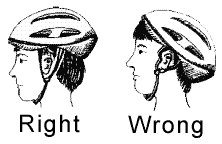
3. Be Visible and Alert
Even the safest bicyclists face the risk of a collision.
- Be ready to yield to vehicles waiting at stop signs, in driveways, or parking spaces. They can suddenly pull out in front of you.
- Be alert to vehicles that have just passed you and may be turning right in front of you, as well as drivers coming toward you in the opposite lane that may turn left in front of you.
- Use hand signals before turning or changing lanes to warn drivers or other cyclists around you. It is not necessary to keep your arm extended while completing a turn; always keep one hand on the handlebars to maintain control.
- To signal a left turn, look behind you, over your left shoulder, and then extend your left arm out.
- To signal a right turn, hold your left arm up with your elbow bent.
- To signal that you are slowing or stopping, extend your left arm down.
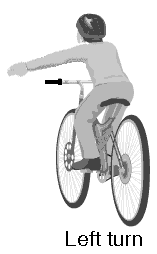
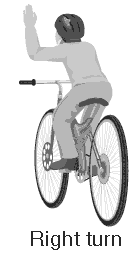
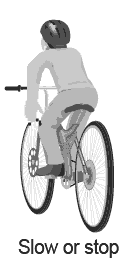
The law requires the use of lights and reflectors at night (CVC §21201). After dark, bicyclists should avoid wearing dark clothing and must have the following equipment:
- A front lamp emitting a white light visible at a distance of 300 feet.
- A rear red reflector or a solid or flashing red light with a built-in reflector visible from a distance of 500 feet.
- A white or yellow reflector on each pedal or on the bicyclist’s shoes or ankles visible from a distance of 200 feet.
- A white or yellow reflector on the front wheel, a white or red reflector on the rear wheel, or reflectorized tires.
Use mirrors only as an aid. ALWAYS look over your shoulder to make sure the lane is clear before turning or changing lanes.
4. Ride in a Safe Lane Position
Ride in the same direction as traffic so you are seen by drivers entering roads or changing lanes, for example:
- Passing a vehicle or another bicycle in the same direction.
- Preparing to make a left turn at an intersection, into a private road, or at a driveway.
- When necessary to avoid a hazard or road condition (i.e., pedestrians, animals, surface hazards).
- When a lane is too narrow for a bicycle and vehicle to travel safely side by side within the lane.
- When approaching a right turn.
- If the road is one-way with two or more lanes. In this case, a bicyclist may ride as near to the left curb or edge of the roadway as possible.
Hazards
Always be on the lookout for potholes, loose gravel, broken glass, storm drain grates, puddles and other unsafe road conditions. Whenever possible, signal before changing lanes. Slow down when approaching an intersection in case approaching traffic doesn’t see you.
Parked Vehicles
Whenever possible, ride far enough away from parked vehicles to avoid being hit by an opening car door.
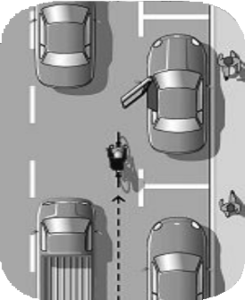
Bicycle Lanes
Bicycle lanes are designated traffic lanes for bicycles. However, motorists must merge into a bicycle lane when making right turns. These lanes are indicated by a solid white line, which becomes a dotted line ending before it reaches the corner. While a simple white line indicates the edge of the road, a bicycle lane follows specific width requirements and is clearly marked as a bike lane with symbols and/or signs. Bicycle lanes can be painted a bright green color in order to increase visibility and should be treated just like any other bicycle lane.
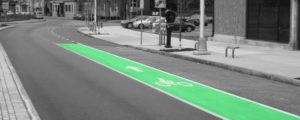
Obey Traffic Signs and Signals
Bicyclists must obey all STOP signs, traffic signal lights and follow basic right-of-way rules. Do not cross through an intersection with a yellow signal light if you cannot make it across the intersection before the light changes to red.
Left Turns
There are two approved methods for making a left turn on a bicycle:
1. Using Traffic Lanes
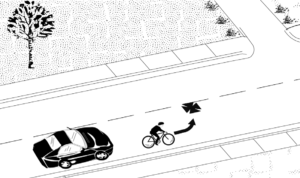
As you approach the intersection, look back over your left shoulder for traffic behind you. If clear, signal your left turn and move over to the left side of the lane, or into the left or center turn lane. Use the whole turn lane, and position your bicycle so that vehicles turning the same direction behind you cannot pass you. Yield to oncoming traffic before turning. If you are riding in a bicycle lane or on a multi-lane road, look and signal every time you change lanes. Never make a left turn from the right side of the road, even if you are in a bicycle lane.
2. Using Crosswalks
Alternatively, stop at the intersection and cross as a pedestrian in the crosswalk, or make a 90-degree left turn and proceed as if you were coming from the right. If the intersection is controlled by a signal light, wait for the green light or WALK signal before crossing. Always yield to pedestrians in a crosswalk.
Other Safety Tips:
- Never wear dual headphones while riding a bike. While not recommended, the use of a one-ear headphone (i.e., a blue tooth headset) is legal
- Wear bright colored clothing
- Dress for the weather and plan for changing temperatures
- Take a Bike class to learn proper riding skills
